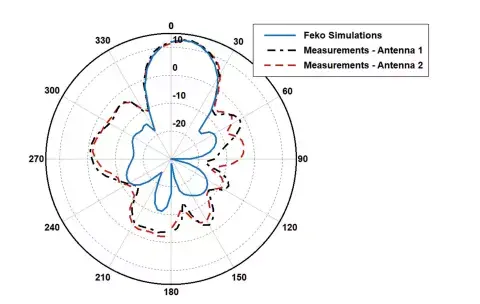
RF2B
REDUCED PHASED ARRAY ANTENNA DESIGN TIME BY 25% WITH ALTAIR® FEKO®
About the Customer
Founded in 2012, RF2B provides high performance design services for antenna and RF design and validation services across air interfaces and bands. RF2B provides validation services based on disruptive system level methodology and turn-key development of application reference radio frequency integrated circuit designs.
Their Challenge
RF2B designed an electronically scanned array, or a phased array, antenna proof of concept design for small cell CBRS (Citizens Broadband Radio Service) base stations at 3.5GHz for its customer Menlo Micro, who develops high-performance Radio Frequency MEMS switch integrated circuits. Menlo Micro developed a reference design for 3.5GHz MEMS Based Differential Delay Shifter (DDS) using its RF switches that can be a great building block for electronically scanning antenna array in place of traditional phase shifters, which are band limited as well as expensive. The goal with antenna array design for CBRS band was to achieve enough azimuth and elevation beam steering range with enough grating lobe suppression and higher efficiency. That required high-level simulation tools to decide number of columns and rows, element type, element spacing, angular step size, and amplitude tapering for the antenna array.
Another challenge was the overall complexity of the design. This scenario required a time efficient antenna array simulation and design methodology that included the feed network as well. Also, the antenna array needed to be optimized in its mechanical environment including the enclosure and radome.
Our Solution
Altair Feko comes with a feature called finite array analysis, plus a built-in script that synthesizes the antenna array. These features significantly sped up the high-level trade off analysis due to model building acceleration and lower memory consumption leading to much quicker simulation times, which is critical during the high-level design phase.
Results
At earlier stages in the design process, the various blocks were modeled with multiport S-parameters which integrated well in to the Feko non-radiating network schematic function. Trade off analysis for materials used and separation to the antenna array used when adding the antenna enclosure and the radome by results from Feko simulations, made it possible for the optimized antenna array design. The whole design was processed using a standard engineering desktop workstation while still accomplishing simulation run times that met the end customers schedule deadline successfully.
The antenna array was fabricated as simulated and designed, and was validated in an anechoic chamber with test results for the achieved gain, steering range of the beam and antenna array efficiency. Excellent agreement with Feko simulations is observed as shown in the Figure on top. Disagreement in the sidelobes and back lobes is artifact of source cables etc. CBRS Antenna
Measured Patterns compared with Feko simulations at 3.62GHz. Dotted lines are measured patterns of two antennas fabricated and solid line is Feko simulations.

Fig 1: Comparison between Feko simulation results and actual measured values

"Altair Feko’s unique features such as finite array analysis and synthesis combined with lower memory requirements were key to faster and accurate simulations and helped us complete our design in time to deliver a fully validated phased array antenna product to our customer."
Mats Lindstrom,
President and CEO, RF2B
